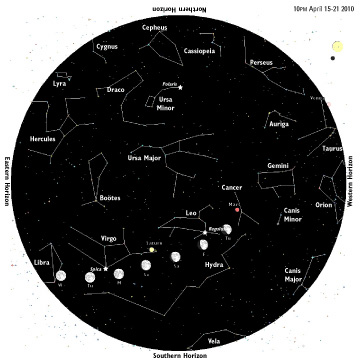Chesapeake Bay's Independent Newspaper ~ Since 1993
1629 Forest Drive, Annapolis, MD 21403 ~ 410-626-9888
Volume xviii, Issue 16 ~ Apri 22 to April 28, 2010
Home \\ Correspondence \\ from the Editor \\ Submit a Letter \\ Classifieds \\ Contact Us
Best of the Bay \\ Dining Guide \\ Home & Garden Guide \\ Archives \\ Distribution \\ Advertising![]()


Sky Watch

by J. Alex Knoll
Turn off the Lights
Misdirected illumination is robbing us of our night skies
The waxing moon rises mid-afternoon at week’s end, dimly visible against a clear blue sky even in daylight. With Friday’s sunset at 7:51, the gibbous moon appears high in the southeast, with the silvery-hued, first-magnitude star Spica six degrees higher — well within the field of view of most binoculars. Saturday the moon shines to the west of Saturn, and Sunday closer and to the east of the ringed planet. Monday and Tuesday, the moon shines less than 10 degrees below the brilliant white light of Spica.
Wednesday marks April’s full moon, the milk moon or the planting moon. Rising with sunset and setting the next morning as the sun rises, the full moon shines bright enough that just about anyone anywhere is able to see it, even in slightly hazy and overcast conditions. But I’ve been told over the years that friends and readers are unable to see some of the objects I write on, like the minor constellations, star clusters and even summer’s Milky Way. The culprit: light pollution.
In cities like Washington, New York or Chicago there’s no escaping the glare. There, on a clear night you might at best see the moon, the major planets and maybe the 10 brightest stars.
But outside of these urban hot spots, light pollution is not the unavoidable cost of civilization but rather the result of misused and misdirected light. Across the country, many municipalities have taken a stand against light pollution, opting for downward-directed and yellow-hued street lights.
On the home front, you can make a difference by minimizing your use of outdoor lighting. Make sure that the outdoor fixtures you do use are well shielded and direct the light only to where it is needed.
For more information, check out the International Dark-Sky Association: www.darksky.org.?
Illustration: © Copyright 1925 M.C. Escher/Cordon Art-Baarn-Holland; Graphics: © Copyright 2010 Pacific Publishers. Reprinted by permission from the Tidelog graphic almanac. Bound copies of the annual Tidelog for Chesapeake Bay are $14.95 ppd. from Pacific Publishers, Box 480, Bolinas, CA 94924. Phone 415-868-2909. Weather affects tides. This information is believed to be reliable but no guarantee of accuracy is made by Bay Weekly or Pacific Publishers. The actual layout of Tidelog differs from that used in Bay Weekly. Tidelog graphics are repositioned to reflect Bay Weekly’s distribution cycle.Tides are based on National Oceanic and Atmospheric Administration and are positioned to coincide with high and low tides of Tidelog.
© COPYRIGHT 2010 by New Bay Enterprises, Inc. All rights reserved.
